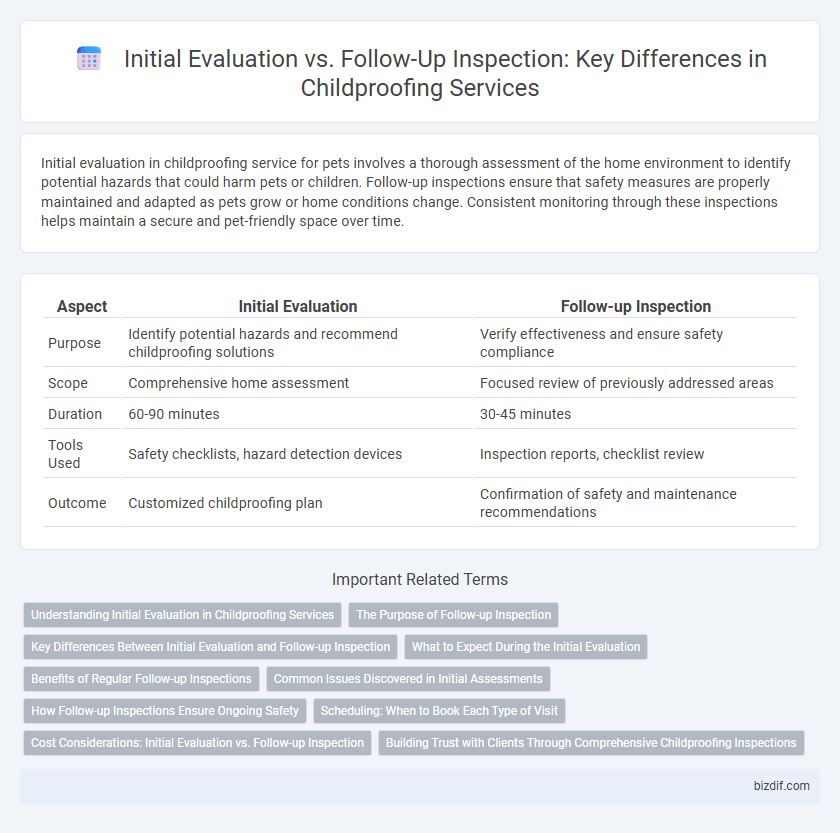Initial evaluation in childproofing service for pets involves a thorough assessment of the home environment to identify potential hazards that could harm pets or children. Follow-up inspections ensure that safety measures are properly maintained and adapted as pets grow or home conditions change. Consistent monitoring through these inspections helps maintain a secure and pet-friendly space over time.
Table of Comparison
| Aspect | Initial Evaluation | Follow-up Inspection |
|---|---|---|
| Purpose | Identify potential hazards and recommend childproofing solutions | Verify effectiveness and ensure safety compliance |
| Scope | Comprehensive home assessment | Focused review of previously addressed areas |
| Duration | 60-90 minutes | 30-45 minutes |
| Tools Used | Safety checklists, hazard detection devices | Inspection reports, checklist review |
| Outcome | Customized childproofing plan | Confirmation of safety and maintenance recommendations |
Understanding Initial Evaluation in Childproofing Services
The initial evaluation in childproofing services involves a comprehensive assessment of a home to identify potential hazards such as sharp furniture edges, accessible cleaning supplies, and unsecured electrical outlets. This detailed inspection ensures customized safety solutions tailored to the unique layout and needs of the household. Understanding this process is crucial for effectively preventing accidents and creating a secure environment for children.
The Purpose of Follow-up Inspection
Follow-up inspections in childproofing services ensure that all safety measures installed during the initial evaluation remain effective and intact over time. These inspections identify any new hazards or damage to protective devices, allowing for timely adjustments or repairs. Consistent follow-up enhances long-term safety and peace of mind for parents and caregivers.
Key Differences Between Initial Evaluation and Follow-up Inspection
The initial evaluation identifies potential hazards in a child's environment by thoroughly assessing all rooms, furniture, and devices for safety risks. Follow-up inspections focus on verifying that recommended safety measures have been implemented correctly and continue to meet safety standards over time. Key differences include the scope of assessment--comprehensive hazard identification during the initial evaluation versus targeted compliance checks and maintenance during follow-up inspections.
What to Expect During the Initial Evaluation
During the initial evaluation of childproofing services, a certified safety expert conducts a thorough assessment of the home to identify potential hazards such as sharp corners, electrical outlets, and unsafe furniture. Experts provide tailored recommendations including installation of safety gates, outlet covers, and secure cabinet locks based on the specific needs of the child's age and behavior. This detailed evaluation sets the foundation for customized childproofing solutions designed to create a safer environment before the follow-up inspection ensures all measures are properly implemented and maintained.
Benefits of Regular Follow-up Inspections
Regular follow-up inspections in childproofing services ensure that safety measures remain effective as children grow and environments change. These inspections identify new hazards, reinforce the proper use of devices like outlet covers and gates, and adapt safety strategies to evolving child development stages. Consistent monitoring helps maintain a secure home, reducing the risk of accidents and providing ongoing peace of mind for parents.
Common Issues Discovered in Initial Assessments
Initial evaluations in childproofing services commonly identify hazards such as unsecured furniture, accessible electrical outlets, and toxic household items within children's reach. Follow-up inspections assess the effectiveness of implemented safety measures and ensure no new risks have emerged. Addressing these common issues early reduces the likelihood of accidents and reinforces a safer environment for children.
How Follow-up Inspections Ensure Ongoing Safety
Follow-up inspections are essential in childproofing as they identify new hazards that may arise after the initial evaluation, such as changes in furniture arrangement or worn safety devices. These inspections verify that previously installed safety measures remain effective and properly maintained, preventing potential accidents. Regular follow-up visits ensure continuous protection, adapting safety solutions to the evolving environment and the child's developmental stages.
Scheduling: When to Book Each Type of Visit
Schedule the initial evaluation before a child-proofing project begins to identify potential hazards and tailor safety solutions specifically to your home. Book follow-up inspections typically 3 to 6 months after installation to ensure all safety measures remain effective and address any new concerns. Timely scheduling improves the long-term safety and functionality of childproofing installations.
Cost Considerations: Initial Evaluation vs. Follow-up Inspection
The initial evaluation for childproofing service typically incurs higher costs due to a comprehensive assessment of potential hazards and tailored recommendations, while follow-up inspections are generally less expensive, focusing on verifying the effectiveness of previous measures and identifying any new risks. Pricing for the initial evaluation often includes detailed reports and consultations, whereas follow-up visits require less time and resources, translating to lower fees. Understanding these cost differences helps families budget effectively for ongoing childproofing needs to maintain a safe environment.
Building Trust with Clients Through Comprehensive Childproofing Inspections
Initial evaluation in childproofing services identifies potential hazards and establishes a personalized safety plan tailored to the child's environment. Follow-up inspections verify the effectiveness of installed safety measures and address any emerging risks or client concerns. Consistent, thorough inspections build trust by demonstrating commitment to the child's ongoing safety and the family's peace of mind.
Initial Evaluation vs Follow-up Inspection Infographic

 bizdif.com
bizdif.com